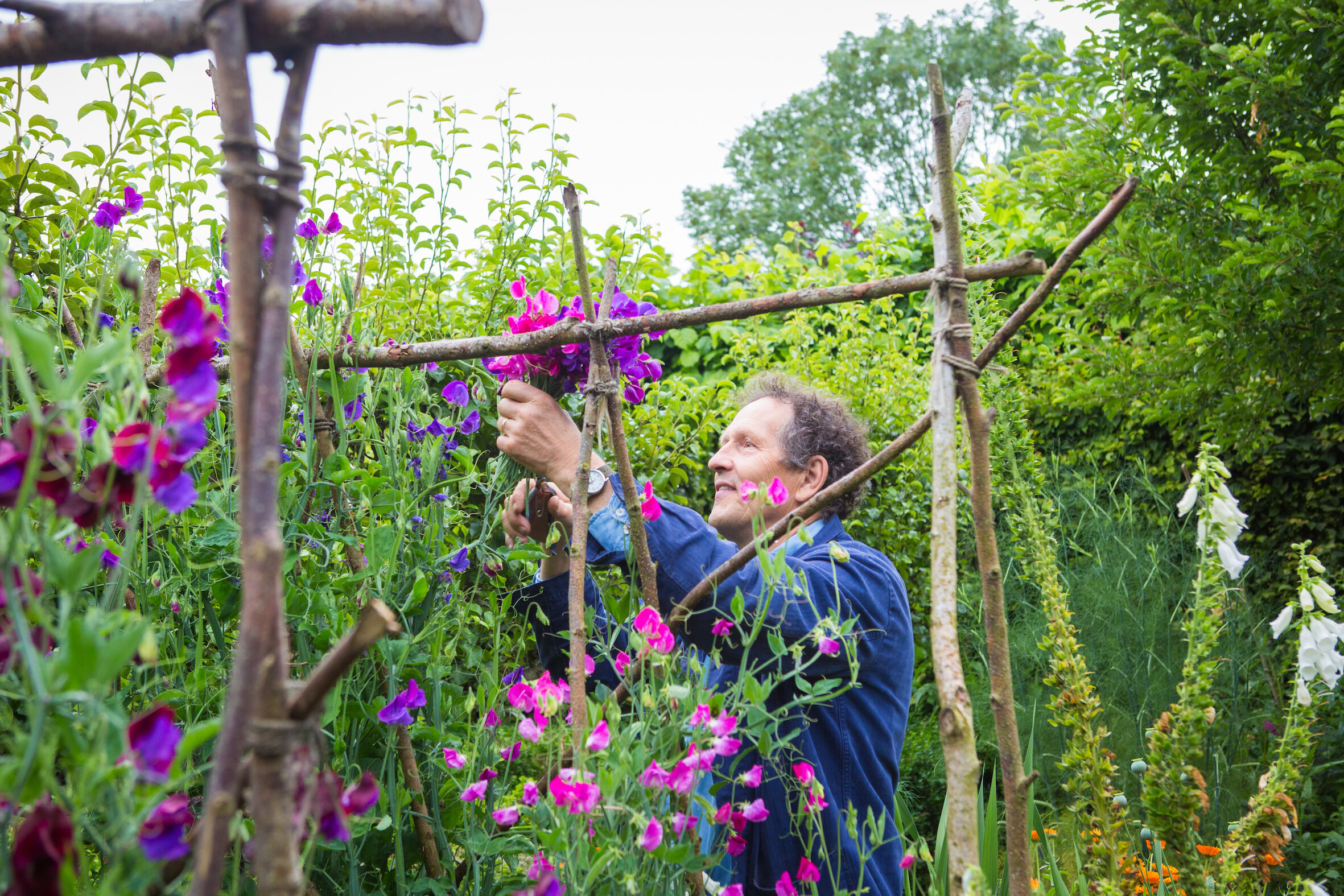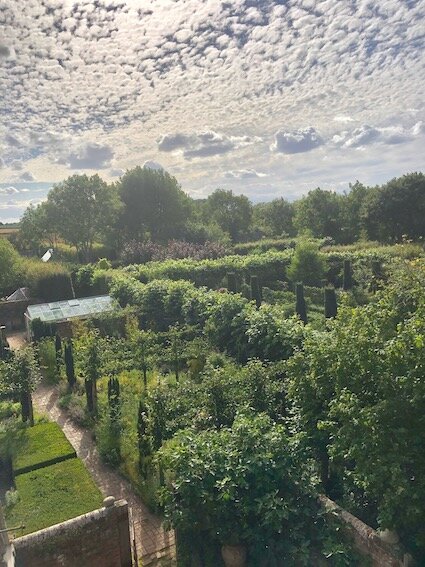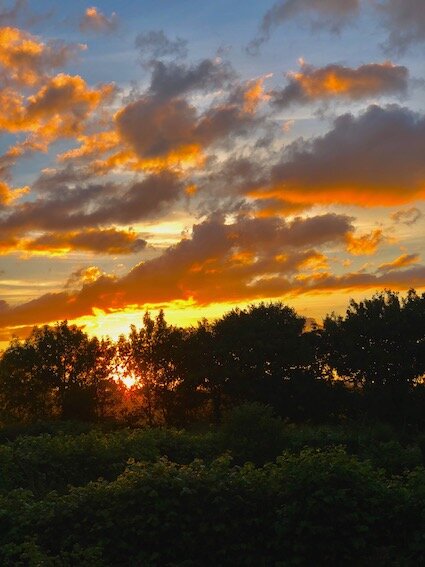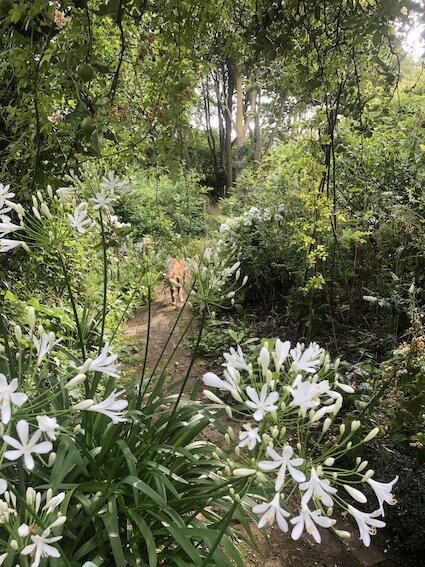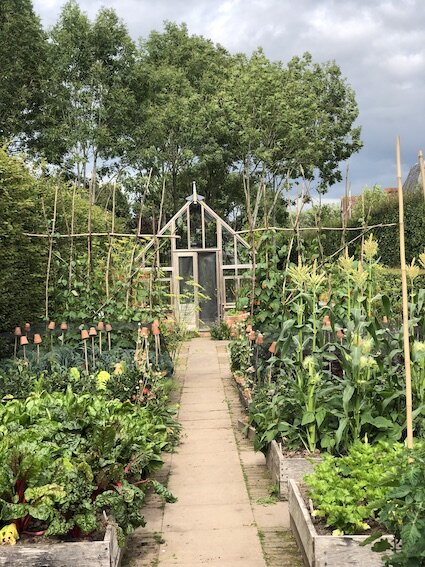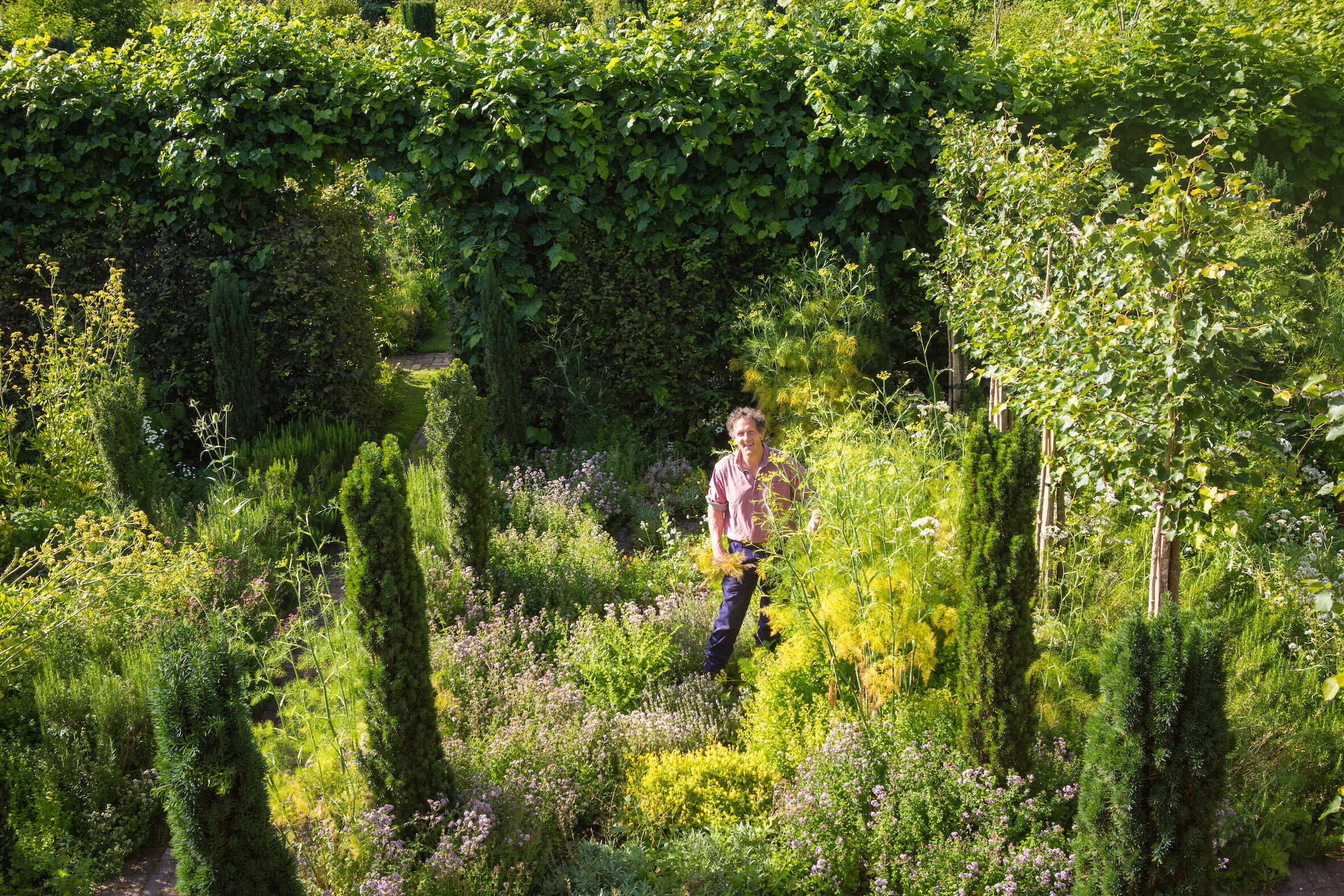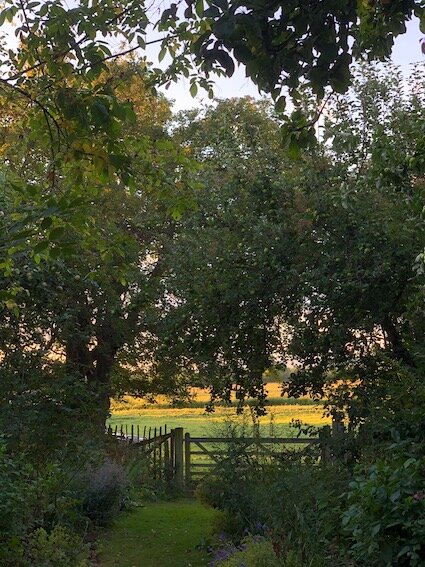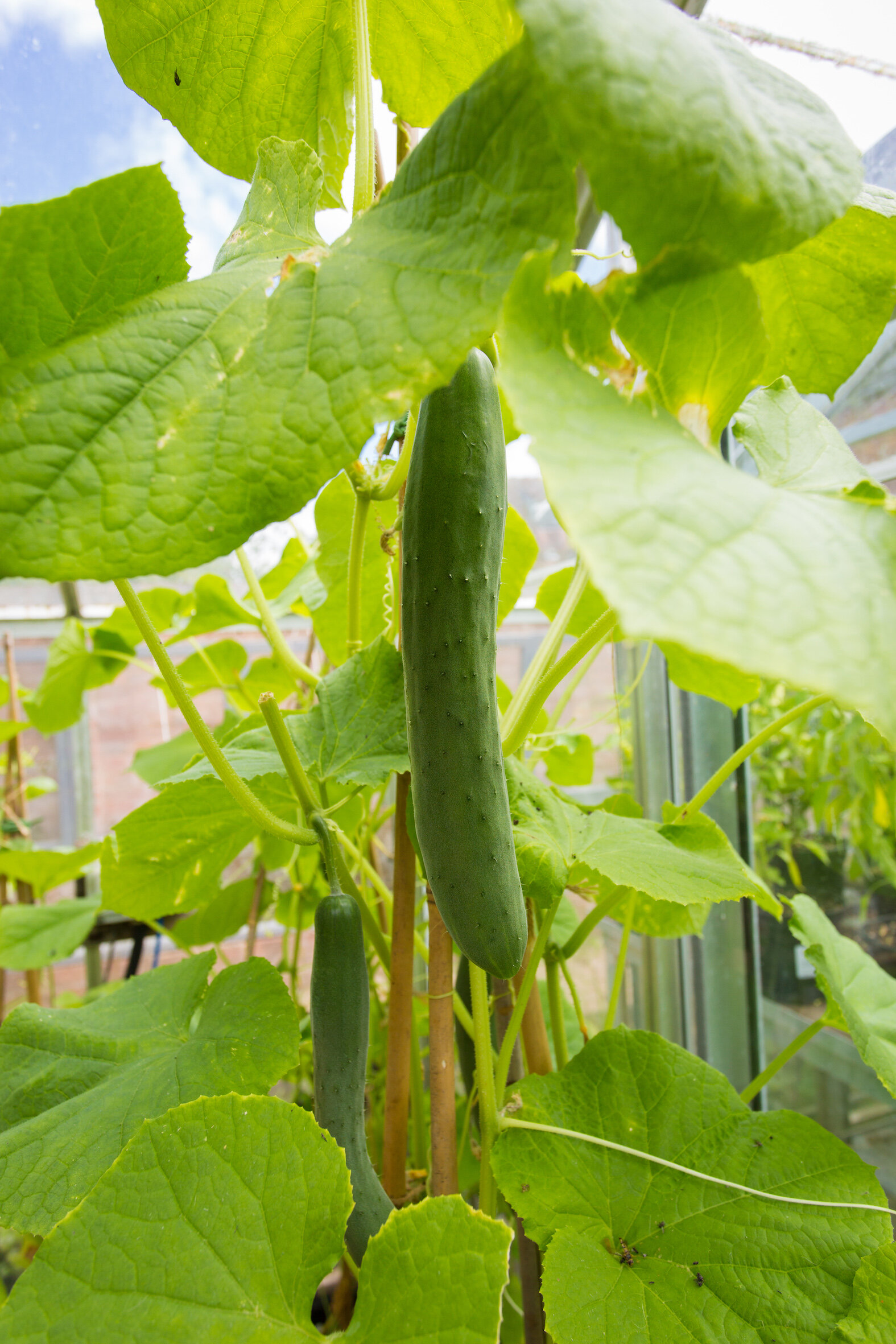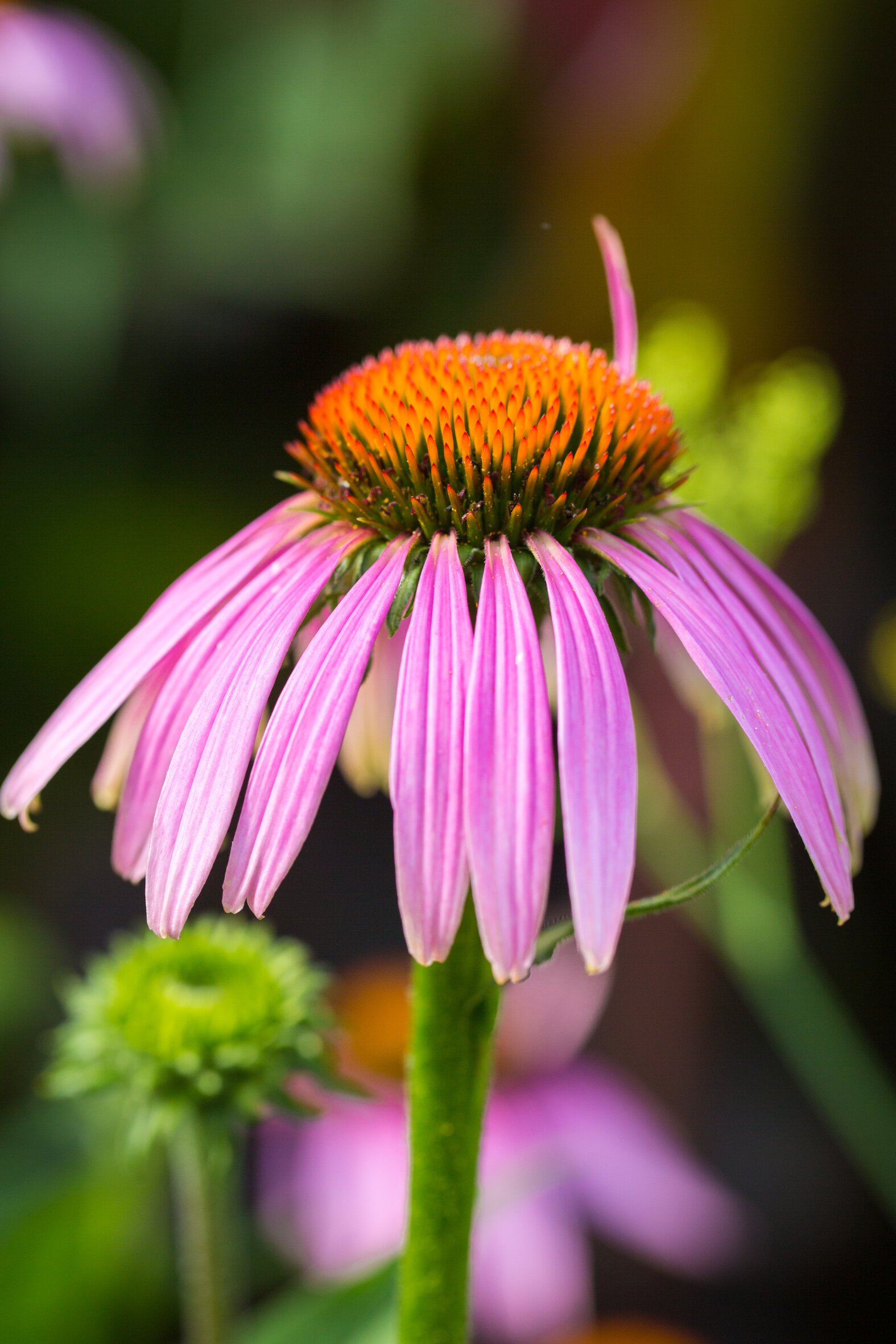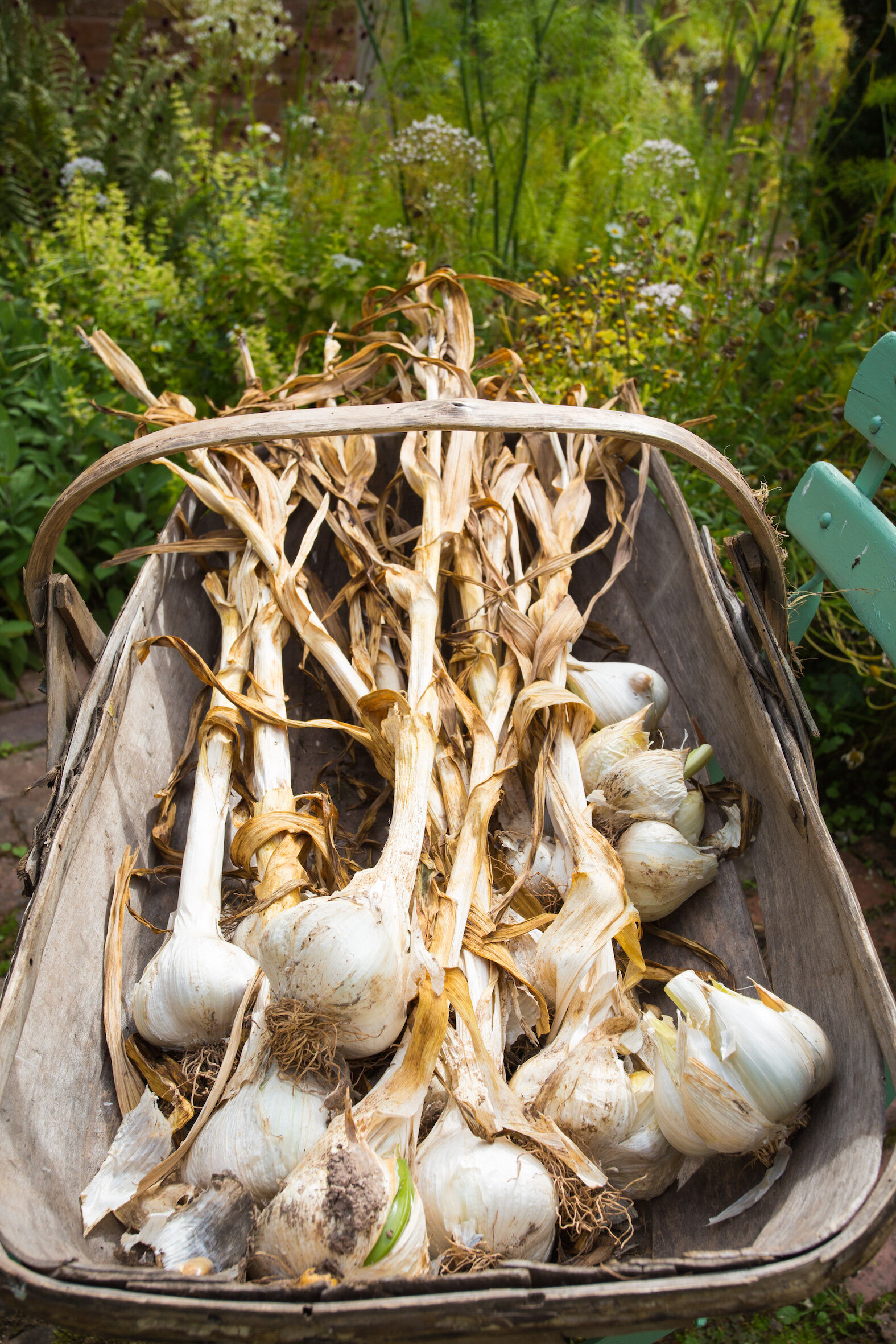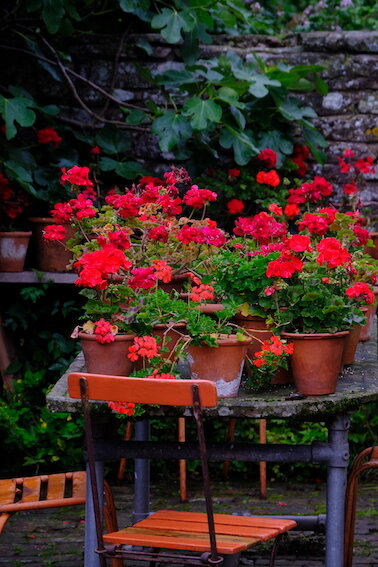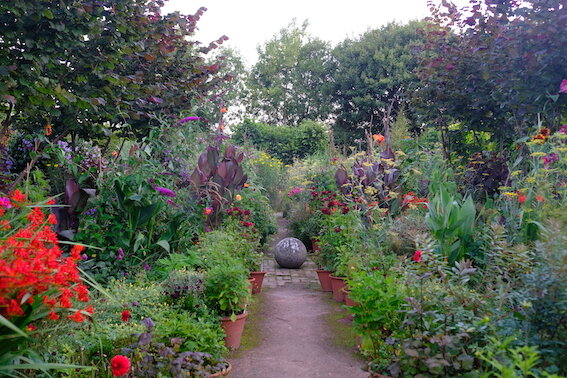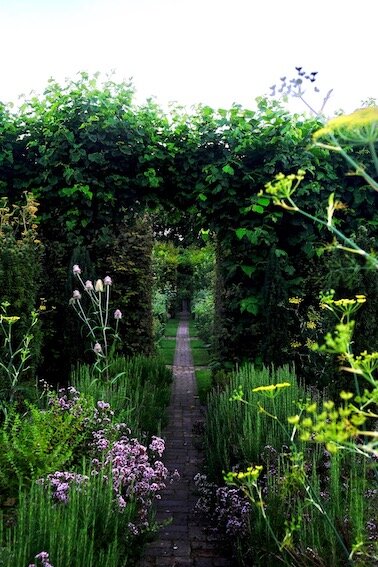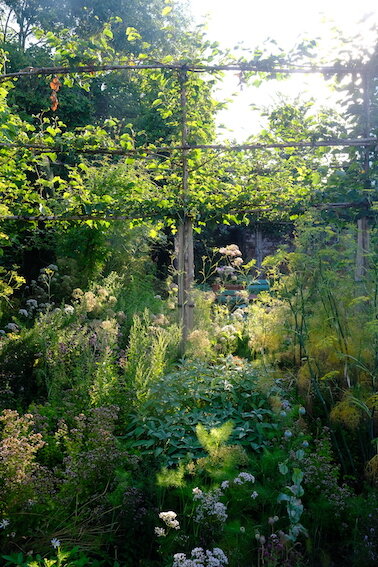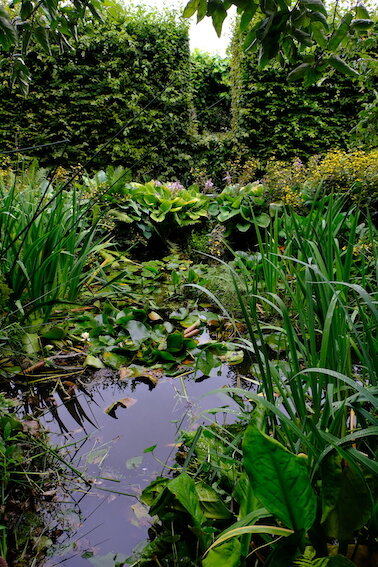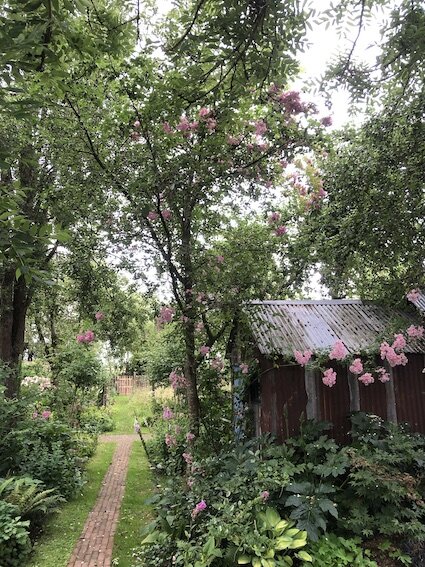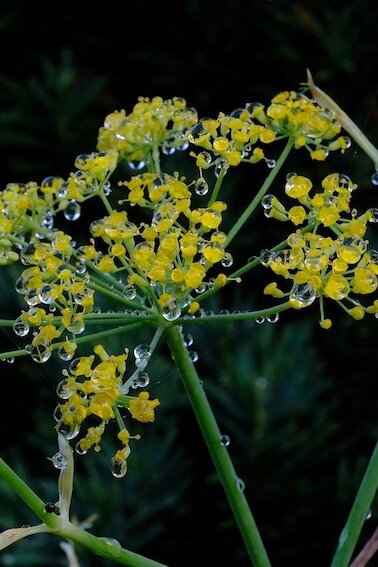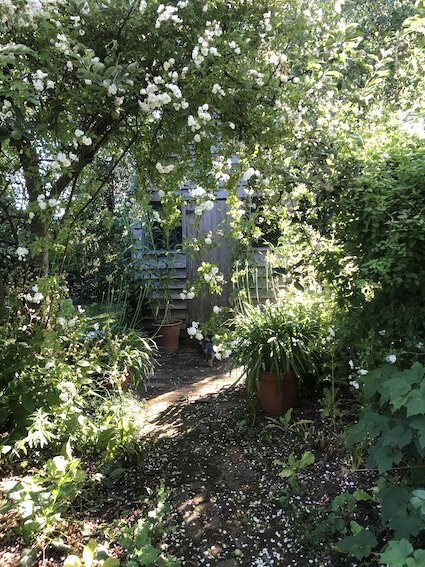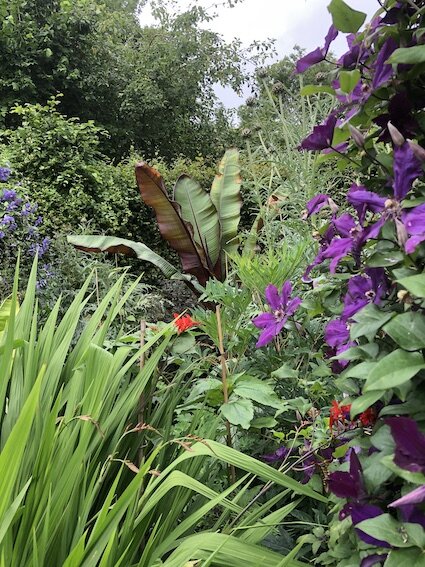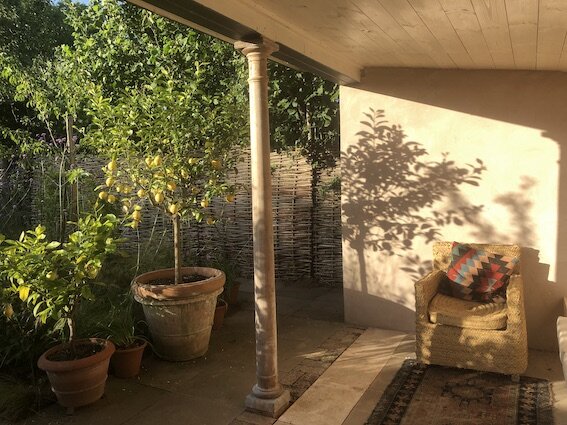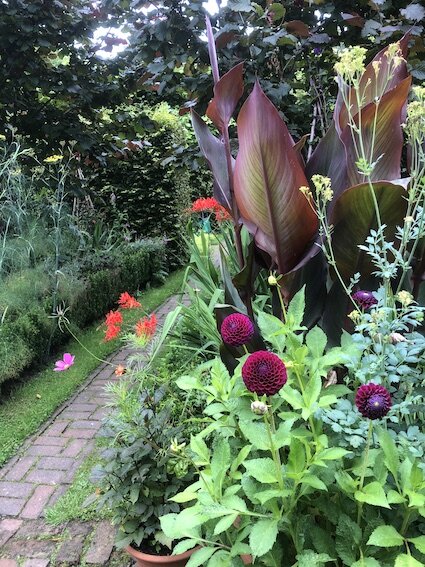July 2021
Mid summer, middle of the year, mid season. But in fact July is the beginning of a new year for me with my birthday falling at the end of the first week. It is time both for celebration of the beauty of an English garden at its best and also to take stock. In gardening terms it is a period of transition. The garden changes and there is a real shift in the borders. The easy lightness of May and June is replaced by a weightier heft from more voluptuous plants.
Canna’s, dahlias, sunflowers, cosmos – they all flex their muscles. But the sweet peas are at their glorious best and for the first half of the month the roses are radiant. The vegetable garden is starting to really bear forth with peas, beans, salad crops, new potatoes, beetroot, garlic, carrots and artichokes all demanding harvest.
It is a time of plenty and feasting with meals eaten outside in the warm summer nights. But it is also a time when the light gently begins to draw in and the days get shorter. From now on nothing can be taken for granted. Summer - whatever the weather - is slipping gently through our hands and must be relished at every opportunity.
FILMING AT LONGMEADOW
It is with delight and excitement that we have resumed filming Gardeners World at Longmeadow with a full crew. The implications of this might bot be fully apparent on screen but for those of us involved it is life-changing.
Since April last year we have filmed every week using robot cameras connected to the operators in separate metal shipping containers parked in our driveway by over 5 miles of cabling.
I delivered my pieces to robot cameras, connected only to the director and cameraman by walkie talkie and not once, in over 30 programmes shared the garden with another soul as we filmed. It was a challenged but we did it - thanks mainly to the brilliance of the production team, all working in isolation at home.
But now that we are back together as a team, moving around, building sequences, sharing ideas, it brings home what a strange time it has been.
Much as I respect and admire the crew that did the remote filming, I fervently hope we never have to go back to that.
JULY JOBS
OUTDOOR TOMATOES
I do not plant my outdoor tomatoes until June. But once they are in the ground they will grow strongly and need regular tying up. This is, of course, if you are growing cordon tomatoes rather than bush or determinate varieties. The latter can be propped up rather like an herbaceous plant rather than tied regularly in.
As I tie them with soft twine I pinch out the side shoots and then water them. I do not feed the outdoor ones as our soil is plenty rich enough and they had a good mulch of compost just before planting, but the indoor tomatoes will have a weekly seaweed feed at the same time.
From late July the risks of blight increase, dependant as it is upon the combination of high humidity and warm days and nights. The best defence for outdoor tomatoes is good ventilation and stripping off the lower leaves as the fruits develop helps this, as well as helping the ripening tomatoes have maximum exposure to sun.
CUT BACK EARLY FLOWERING PERENNIALS
Early flowering perennials such as oriental poppies, delphiniums and hardy geraniums such as g. phaeum and should all be cut back to the ground to encourage fresh regrowth and repeat flowering in a couple of months time. This also creates space for tender annuals and perennials in the border. Remove all cut material to the compost heap, weed around the base of the plants, water if necessary and do not plant too close to them so that they have light and space to regrow and flower again at the end of summer.
SUMMER PRUNING APPLES AND PEARS
Pruning apples and pears at this time of year in summer is very useful for trained forms like espaliers, cordons or fans or mature trees that have become to large or crowded because, unlike winter pruning, done when the tree is dormant, this hard cutting back will not stimulate vigorous regrowth. Unless you are training a particular new shoot, remove all this year’s growth back to a couple of pairs of leaves (usually about 2-4 inches) being careful not to remove any ripening fruits. If you are training the fruit to a particular shape, tie desired but loose growth in as you go. Cutting it back now also allows light and air onto the fruit that is ripening and stops your trees becoming too crowded with unproductive branches.
STAKING
The extra warmth of July - and the wetness that comes with it - often leads to a flush of lush growth that plants cannot support. The result is that borders can start to fall all over the place, plants outgrowing themselves and toppling chaotically - especially if lashed by rain winds or thunderstorms and what was lovely profusion can become a disaster zone overnight.
So it is good to have some brush wood such as hazel pea sticks or metal supports ready and to gently work round the borders easing plants upright and providing the underpinning that they need - but without reducing the border to a stiffly corseted state that loses all the charm of midsummer bounty. Ideally it should not look as though you have done anything at all.
This can often apply to taller growing annuals such as ammi majus, sunflowers, cleome, Cosmos sensation, tithonias and Leonotis - all of which are stalwarts of Longmeadow. As these are planted individually it is hard to support them in the gently bolstering fashion that suits a large herbaceous perennial, but they can be staked to half their height and tied with soft twine so that they can still move gently but not collapse completely.
CUT HEDGES
Young birds will have left their nests by now so hedges can be safely cut. A trim now will allow any subsequent regrowth to harden off before possible autumnal frosts.
Start by cutting the sides. Be sure to make the base of the hedge wider than the top - regardless of the height. This ‘batter’ allows light to reach the bottom half and ensures full, healthy foliage down to the ground. Then cut the top, using string as a guide to keep it straight and level. If it is an informal hedge, curve the top over so it is rounded.
If you have an overgrown hedge now is the best time to reduce it in size whereas if you have a hedge that needs reinvigorating, wait until winter and trim it hard when it is dormant. This will promote more vigorous growth next Spring.
If the hedge trimmings are not prickly they will be soft enough to chop up with a mower and added as a useful contribution to the compost heap.
PICKING RASPBERRIES
I would trade the very best strawberry for any raspberries and the summer fruiting varieties are at their best in July. Summer-fruiting raspberries carry their fruit on the canes that grew the previous summer - so all the fresh growth made in the current year will crop next July - whereas autumn-fruiting types such as ‘Autumn Bliss’ produce their fruit on the new-season’s growth. There is a freshness and seasonal treat to the summer raspberries that makes them especially good and we often pick a bowl just before supper and eat with a little cream whilst they are still warm from the evening sun. Heaven!
FEEDING CONTAINERS
Most plants grown in a container of any kind will exhaust the available nutrients from the compost they were originally planted as they grow and will need a regular supplementary feed for the rest of the summer. A weekly feed high in potash that will help promote root and flower formation (but not over-lush foliage) is ideal. I find liquid seaweed or a proprietary liquid tomato feed to work well.
The secret is to give just enough - and not too much. Too many nutrients is as damaging as too few as it causes rapid, lush growth - often at the expense of flowers or fruit - and which attracts extra fungal and predatory problems.Never be tempted to make the feed any stronger than the instructions dictate and if in any doubt reduce the strength. Your plants and displays will be the better for it.
PRUNING RAMBLING ROSES
It is very important to keep dead-heading roses as the petals fade to encourage repeat flowering, but some roses have now finished all that they are going to do this year. Most ramblers fall into this category, especially in the south of the country and such as ‘Wedding Day’, ‘Paul’s Himalayan Musk’ or ‘Felicite Perpetue’ should be pruned as soon as they have finished flowering. If you are in doubt as to whether your rose is a climber or a rambler, ramblers tend to be much more vigorous and always have a mass of small flowers that never repeat once they have finished.
Many ramblers are best grown into a tree and these can be left unpruned apart from straggly, unkempt, growth. However if space is limited or you training the rose in any way this year’s new shoots should be tied in or cut back according to the circumstance. Remove any damaged or very old shoots, cutting them right back to the ground.
If training round a vertical support it is best to wind the stems in a spiral. Otherwise, the more horizontal the stems can be trained, the more flowers will be produced next year.
Finally, tie in any loose growth and mulch well.
SOWING PARSLEY
I like to have a constant supply of parsley which can easily be done as long as you make successional sowings and now is the best time to sow the seeds that will provide plants for harvesting through winter and the first part of next spring. When the seed has germinated prick out the seedlings into individual pots or plugs and grow them on until large enough to plant out.
Do not be tempted to leave a sprinkle of seed that develops into a bunch of spindly seedlings but thin and encourage each individual plant to be strong. Space them at least 9 inches apart and allow each to became really vigorous. The well-spaced plants will have a big root and recover quickly from being cut back by throwing up more fresh leaves and thus provide a much better source of leaves for a longer period.
POTATO BLIGHT
One of my yearly rituals is to dig first early potatoes on July 8th, my birthday. The harvest varies hugely depending on when I planted them and the subsequent weather, but tradition demands I lift enough for a celebratory meal.
I now only grow first earlies because the risk of blight is so great. Potato blight is a fungal disease that rots first the haulms and then, as it is washed into the soil by rain, the tubers making them unstorable if not inedible. The fungae develop very fast when the temperature is high and the air humid for 23 hours and these conditions are becoming increasingly common in July. The crop can be saved if the foliage is removed immediately the tell-tale chocolate coloured circular areas of the leaves is noticed - they quickly spread and collapse.
Remove all foliage and compost it (the fungae do not survive the composting process) and make sure that there is a good soil covering over the tubers. Then wait for a dry day and harvest the crop.
First and second early varieties are much less likely to be affected because they mature faster and are ready for harvesting earlier in the season.
PICKING SWEET PEAS
Few garden chores can be as pleasant or undemanding as this but be sure to regularly pick all the flowers from your sweet pea plants is the best way to extend their flowering season. Sweet pea flowers will rapidly develop seed pods in warm weather and these drain energy from the plant and trigger more seed production at the expense of flowers. I have found that the optimum picking period for sweet peas is about 10 days. It is important to remove every single flower - and to enjoy the resulting fragrant bunches of blooms for the house.
Use scissors and cut the stems as long as possible and as soon as you see any seed heads remove them immediately. This way, in a cool summer, the plants can go on flowering right into September.
HARVEST GARLIC AND SHALLOTS
If the leaves are yellowing and seed heads are forming, this is a good indication that Garlic and shallots (and onions too if they are ready, although they may need a few more weeks yet) are usually ready to harvest. Always use a fork to carefully lift them rather than yanking them out of the soil by hand as you want to try and avoid damaging the roots and especially the root-plate - where they attach to the bulb.
Clean any surplus soil but do not remove any foliage or roots before putting them to dry thoroughly. This can be done by leaving them on the soil if it is dry and warm, on a home-made rack made from chicken wire stretched over posts or in a greenhouse. Once they are absolutely dry - usually after a few weeks - they can be topped and tailed for storage.
SUMMER PRUNING CURRANTS
After gooseberries, red and white currants have been harvested - which they all will by the end of July - it is a good idea to give them a summer prune. Remove any new growth that is crowding the centre of your bushes and cut back the new shoots you wish to keep by about a third. This will let light and air into the plant, encouraging the wood to ripen and spurs to form which will carry next year’s fruits. Blackcurrants can be pruned hard - removing up to a third of each bush - immediately after harvest.
CUTTING LONG GRASS
All Spring-flowering bulbs should have completely died back so that long grass can be cut without affecting their display next year. At Longmeadow we often wait until August to do this because not all wild flowers have set seed, but by the end of July most wild flower meadows can be safely cut back.
The important thing is to removed all the grass, raking up every last piece to compost so that it will not enrich the grass and thus limit next year’s wild flower display.

